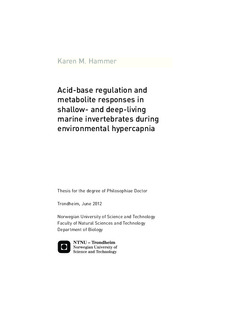| dc.description.abstract | Global warming is considered to be the most adverse consequence from the increasing anthropogenic emissions of CO2. However, in the marine environment additional problems related to the elevated levels atmospheric CO2 may arise; the increased amount of CO2 absorbed by the oceans may lead to a moderate, but consistent and global reduction in seawater pH due to the acidifying effect of CO2, a phenomenon referred to as ocean acidification. Another potential problem may occur as a result of sub-seabed storage of anthropogenic CO2, a disposal alternative introduced by the gas industry to mitigate CO2 emissions to the atmosphere. Leakage from such storage sites could potentially cause a relatively local, but extreme acidification of the seawater near the leakage site. Both scenarios may create unfavourable conditions for marine organisms, and previous studies have reported that environmental hypercapnia (elevated pCO2) may affect an array of physiological processes in marine organisms such as acid-base status and metabolic rate. Deep-living animals are considered to be particularly vulnerable to environmental hypercapnia due to their low metabolic rate and poor ability to counteract effects of environmental stressors.
To predict the possible outcome of the two scenarios described above it is important to understand the physiological mechanisms that marine organisms apply to handle the CO2 stress. During conditions of elevated seawater pCO2, the charge neutral CO2 molecules permeate biological membranes and react with water in the body fluids resulting in the net formation of HCO3- and H+. Thus, the primary effect of elevated pCO2 is induction of body fluid acidosis. Acid-base regulation during acidosis is generally mediated by buffering compounds as well as acid elimination through direct removal of hydrogen ions (H+) and/or accumulation of buffering bicarbonate ions (HCO3-).
In the current thesis the deep-sea bivalve Acesta excavata, the green shore crab Carcinus maenas, and the deep-water prawn Pandalus borealis were exposed to elevated seawater levels of pCO2. The purpose was to study the responses of the different species to elevated pCO2 and to compare the capacity of shallow- and deep-living animals to counteract CO2-induced effects. To meet these objectives changes in acid-base relevant parameters (pH, pCO2, [HCO3-]) and metabolic rate was studied in all three species, while gene expression and activity of ion regulating proteins as well as changes in the metabolome were determined in C. maenas alone.
Calcifying animals, such as bivalves, have been suggested to utilise HCO3- from the calcium carbonate shell to buffer acidosis. However, this buffering strategy may be restricted to closed systems such as during shell closure. Indeed, the findings in the present thesis indicate that shell dissolution does not occur in the deep-living bivalve A. excavata in response to CO2-induced acidosis. Consequently, A. excavata does not seem to be able to compensate extra- or intracellular acidosis in response to severe environmental hypercapnia, and experiences a drop in metabolic rate most likely induced by low body fluid pH. However, this species displays a relatively high nonbicarbonate buffering capacity, and may therefore be able to tolerate more moderate levels of CO2 exposure than that experienced in the present study.
In decapod crustaceans extracellular pH-regulation occurs in the posterior gills by electroneutral ion exchange between the extracellular fluids and the surrounding seawater. The shore crab C. maenas was able to partially compensate extracellular acidosis by accumulating relatively high levels of HCO3- in response to elevated pCO2, and the degree of compensation was dependent on the level of CO2 exposure. The results from the present thesis suggest that this species can compensate acidosis without substantially increasing the acid-base regulatory capacity of the branchial ion transporting proteins. Surprisingly, the deep-water prawn Pandalus borealis exhibited similar abilities as the shore crab to counteract extracellular acidosis induced by elevated pCO2. This was achieved by increasing the extracellular concentration of HCO3- to a similar degree as C. maenas. The findings indicate that this species display similar acid-base regulatory capacities as shallow-living decapods, thus nuancing the picture of the compensating capacities of deep-living animals. Acid-base regulation in both decapod species was achieved without affecting the osmolality of the extracellular fluid. This is in contrast to what has been reported for subtidal decapod crabs. The metabolic rate was not significantly affected in any of the two species, possibly due to their ability to maintain extracellular pH close to normal values.
While acid-base regulation in response to CO2-induced acidosis has received increased scientific attention, only a very few studies have investigated responses of the metabolome to elevated pCO2. 1H-NMR metabolomics revealed that in the green shore crab CO2 exposure induces a shift in the metabolic fingerprint in both hemolymph and extracts of gills and leg muscle. The shift is not the result of changes in metabolites involved in energy metabolism, as could be expected. Rather, it is due to a general decrease in the concentration of metabolites, particularly of important osmolytes such as the amino acids proline and glycine. The observed changes were most prominent after prolonged exposure, suggesting an exhaustive response rather than an active, compensatory mechanism. The results indicate that in response to elevated pCO2 shore crabs experience symptoms resembling those of animals acclimated to condtions of reduced salinity. This may possibly suggests a disturbance of intracellular isoosmotic regulation.
The present thesis indicates that A. excavata would be highly, and possibly permanently affected by severe CO2 exposure associated with CO2 leakage, while both the intertidal and deep-living decapods could tolerate relatively prolonged periods of quite severe hypercapnic conditions. | nb_NO |

